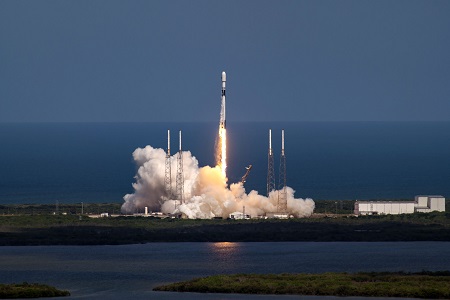
SpaceX (Space Exploration Technologies Corporation) an American aerospace manufacturer and space transportation services company successfully launched Falcon 9 rocket with Space Vehicle 03 (SV03), the next generation third Block III Global Positioning System (GPS) satellite for the US Space Force on Tuesday, 30th June 2020. The taking off was from Space Launch Complex 40 (SLC-40) at Cape Canaveral Air Force Station (Florida) at 4:10 p.m. EDT (2010 GMT).
GPS III SV03 is the 9,505-pound (4,311-kilogram) satellite which is designed by Lockheed Martin Space Systems. It is the third model of its series replacing the previous Block II series with this upgraded version of GPS satellite. It is the third USSF mission launch, second National Security Space launch (NSSL) mission on SpaceX’s Falcon 9 rocket and the first mission where the service provider of a launch aim to recover the booster.
GPS III is considered as the most powerful GPS Satellite bringing a new level of distinction or supremacy for the entire space community. Medium Earth Orbit (MEO) Space Systems Division chief, Col. Edward Byrne said, “The GPS III program continues to build on its successes by delivering advanced capabilities for the United States Space Force, and maintaining the “gold standard” for position, navigation and timing.”
The launch program had been the continuous efforts by the Defence Department to upgrade the current GPS satellites in space. GPS III will operate alongside the constellation of currently operating 31 GPS satellites of United States and would benefit users to connect with more satellites in space with better accuracy.
Here are some key highlights of GPS III-03 :
- More accurate (three times) and powerful signals than previous GPS satellites enabling higher throughput and availability.
- Benefiting 4 billion global users through better signals and more capability.
- Improved navigational performance for military and civilian users.
- Enhanced Military code (M-Code) capable satellite showcasing spot beam capability for more accurate and secure military signals.
- Eighth times (8X) improved anti-jamming capabilities.
- Powerful new regional military protection and full digital navigation payload.
- An accuracy-enhancing array with search and rescue payload.
- Feature of control architecture and a cross-linked command for updating the entire constellation from a single ground station.
- 15 years operational design life for being in orbit for longer run than predecessor GPS satellites.
- Transmitting power of 500 times than earlier systems of GPS.
- New L1C civil signal GNSS compatibility interoperable with Europe’s Galileo Constellation and other GNSS systems.
- Additional broadcast frequencies for more interoperable of GPS network with other navigation satellites fleets.
- Position accuracy of 0.63 m and designed for an orbit more than twelve thousand miles above the earth.
- Based upon the modular framework of Lockheed Martin’s tried-and-true A2100 “bus” that supports electricity of Fifteen kilowatts.
- Designed in a virtual reality environment to maximize efficiency and streamline production.
- Compatible with Air Force’s next generation ground control system and the current GPS constellation.
- Designed to provide the air force flexibility, to meet evolving mission needs and to incorporate new technology.


















